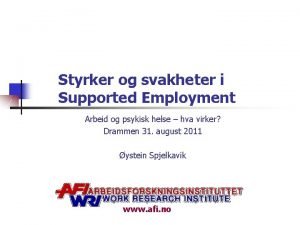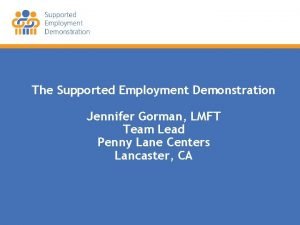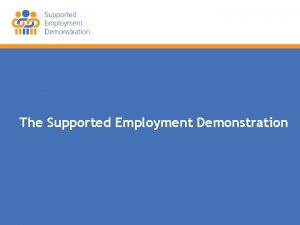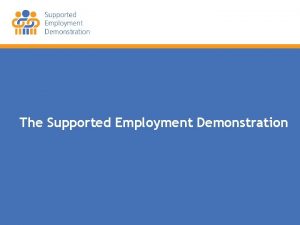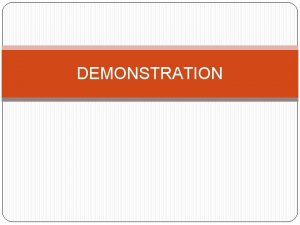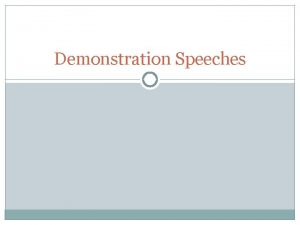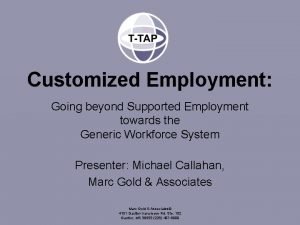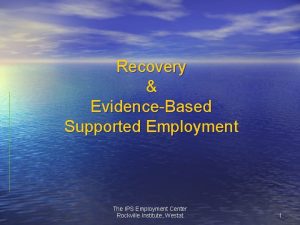The Supported Employment Demonstration Jennifer Gorman LMFT Team














- Slides: 14

The Supported Employment Demonstration Jennifer Gorman, LMFT Team Lead Penny Lane Centers Lancaster, CA

Penny Lane Centers Community Mental Health Agency – 50 years EMPLOYMENT SERVICES 1. Cal. Works Program 2. DOR Contracts Co-op and work experience program in North Hills office TAY Homeless Drop-In Center Offices: • North Hills • Commerce • Lancaster 3. Supported Employment Demonstration Started over 1 year ago 4. Future Veteran’s and Low-Income Housing and Employment Services

Penny Lane Implementation of IPS Increased Fidelity > Improved Outcomes § 2009 -2012: Penny Lane served the Cal. Works population with a focus on employment • Employment rates averaged 10%-15% § 2012: Penny Lane began implementation of IPS with the Cal. Works population and achieved good fidelity • Employment rates increased to 30 -35% § 2014: Exemplary Fidelity was achieved • Employment rates increased to 45 -50% 3

Supported Employment Demonstration Overview § Funded by the U. S. Social Security Administration and run by Westat, who provides researched-based services. § Participant enrollment began in December 2017 § Penny Lane Centers is among 30 community agencies across the country, and the only agency in California, selected to be part of this demonstration § 3, 000 participants § Eligibility: Participants are adults, ages 18 -50, who have been initially denied SSI or SSDI who have alleged mental health impairment § Each participant is followed for 3 years 4

Purpose of the study To look at how employment services, provided along with integrated behavioral health and social services, can help people experiencing mental illness get a good job § Working may eliminate or reduce the need for disability • In 2014, SSA paid nearly $54 billion to over 8 million people • SSA trust fund reserves are expected to be exhausted in 17 years § Increase access of effective employment and behavioral health services earlier • Many SSI applicants don’t receive the treatment or rehabilitations services that could help them recover and enjoy a more productive life • Those receiving SSI often have poor prognosis for improved well-being § Potentially change policy and funding to assist those with mental health and substance abuse problems gain employment 5

Services and Supports Provided Services: § Individual Placement and Support (IPS) employment services (job preparation, job development, job coaching, etc. ) § Behavioral health services (as needed) § Mental Health assessment, diagnosis and treatment plan § Medication management services (as needed) § Care Manager services and linkage to community resources remove barriers to working Other Supports § Funding for Individual Work-Related Expenses § Funding for treatment-approved behavioral health services 6

Three Study Conditions and Involved Agency Providers Study Condition Usual Services Group Services Provided as a Part of the Study None (1) Individual Placement and Support (IPS) Basic Service Group Full Service Group (2) Coordinated Evidence. Based Behavioral Health Care (3) Integration and Coordination of Related Services (1) IPS (2) Coordinated Evidence. Based Behavioral Health Care (3) Integration and Coordination of Related Services (4) Medication Management Support Providers Involved in the Study None Team Lead IPS Specialist Care Manager Nurse Care Coordinator

Evidence-Based IPS (Individual Placement and Support) Supported Employment Evidence-based Supported Employment or IPS: Goal is competitive employment • Pays at least minimum wage and the wage that others receive performing the same work • Based in community settings alongside others without disabilities (Not sheltered work, etc. )

Implementation of Supported Employment Principles at Penny Lane Ø Eligibility based on client choice (Zero Exclusion) Ø Individuals who are interested in work are eligible to participate regardless of mental health diagnosis, disabilities, substance use, etc. Ø (Research for IPS was based on severe mental illness -Schizophrenia, Bipolar Dx, etc. ) Ø Employment services are integrated with mental health services Ø We work as part of a treatment team: therapist, case manager, psychiatrist, employment specialists, substance use counselor, benefits counselor, and supervisor. Ø A weekly treatment team meeting occurs for the Basic and Full groups Ø Collaboration with DOR Ø Penny Lane has an assigned DOR Counselor. Ø A monthly in-person collaboration meeting and regular contact occurs to address employment barriers, needs and goals for shared participants. Ø Penny Lane and DOR cross-trained staff regarding their programs and services. 9

Implementation of Supported Employment Principles at Penny Lane Ø Job Development Ø Rapid job search - Within the first 30 days of enrollment Ø Face-to-face meetings with employers - 6 hiring managers per week Ø Jobs are developed based on a participant’s preferences Ø Job supports are provided to help participants maintain employment Ø Benefits Counseling Ø Trained Benefits Counselor to provide guidance for participants regarding their benefits and employment. 10

EFFECTIVENESS OF IPS IN THE RESEARCH § IPS is more effective • IPS is 3 times more effective than other vocational approaches (such as with prevocational assessment, shelter setting and volunteer work) in helping people with mental illness to work • Competitive Employment rates in 25 Randomized Controlled trials showed a significant advantage for IPS or evidenced-based supported employment • Mean competitive employment rates for the 23 studies: • 55% for IPS • 23% for controls “Making the case for IPS Supported Employment” (www. IPSworks. org) 11

Among 26 vocational practices, only IPS rated highly relevant (3 rd) and highly evidence-based (3 rd) by VR subject matter experts (Leahy et al. , 2018) 12

EFFECTIVENESS OF IPS IN THE RESEARCH § For those with mental illness, employment is part of their recovery • Approximately 2 of every 3 people with mental illness are interested in competitive employment, but only 15% are employed. • Success stories –substance use, homelessness, mental health, physical disabilities § IPS can be cost effective over the long run § When participants return to work, there is a long-term savings in regard to mental health costs. § Once on disability, less than 1% return to work 13

For More Information If you have questions about the Supported Employment Demonstration: Penny Lane Jennifer Gorman, LMFT at 661 -266 -4783 x 2732 jgorman@pennylane. org U. S. Social Security Administration https: //www. ssa. gov/disabilityresearch/contact. htm IPS www. IPSworks. org IPS Supported Employment: A Practical Guide (2013) 25 -Item IPS Supported Employment Guide Online Courses for Practitioners and Supervisors 14
 Supported employment utdanning
Supported employment utdanning Supported employment verktøykasse
Supported employment verktøykasse Mackenzie gorman
Mackenzie gorman Penny gorman
Penny gorman Political bosses apush
Political bosses apush Who is des gorman
Who is des gorman Dr susan gorman
Dr susan gorman Sean gorman edinburgh
Sean gorman edinburgh The gorman manufacturing company must decide
The gorman manufacturing company must decide Team spirit becomes team infatuation
Team spirit becomes team infatuation The white team cheers for the blue team, just like
The white team cheers for the blue team, just like Bureaucratic bypass syndrome
Bureaucratic bypass syndrome Sự nuôi và dạy con của hổ
Sự nuôi và dạy con của hổ đại từ thay thế
đại từ thay thế Quá trình desamine hóa có thể tạo ra
Quá trình desamine hóa có thể tạo ra
